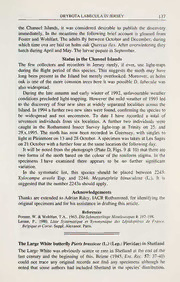Table Of ContentDRYBOTA LABECULA IN JERSEY 37
1
the Channel Islands, it was considered desirable to publish the discovery
immediately. In the meantime the following brief account is gleaned from
Foster and Wohlfart. The adults fly between October and December, during
which time ova are laid on holm oak Quercus ilex. After overwintering they
hatch during April and May. The larvae pupate in September.
Status in the Channel Islands
The few collectors and recorders in Jersey rarely, if ever, use light-traps
during the flight period of this species. This suggests the moth may have
long been present in the Island but merely overlooked. Moreover, as holm
oak is one of the more common trees here it was possible D. labecula was
also widespread.
During the late autumn and early winter of 1992, unfavourable weather
conditions precluded light-trapping. However the mild weather of 1993 led
to the discovery of four new sites at widely separated localities across the
Island. In 1994 a further two new sites were found, confirming the species to
be widespread and not uncommon. To date I have recorded a total of
seventeen individuals from six localities. A further two individuals were
caught in the Rothamsted Insect Survey light-trap at Trinity on 25. and
29.x.1995. The moth has now been recorded in Guernsey, with singles to
light at Pleinmont on 13 and 28 October. A specimen was taken at Les Sages
on 21 October with a further four at the same location the following day.
&
It will be noted from the photograph (Plate D, Figs. 9 10) that there are
two forms of the moth based on the colour of the reniform stigma. In the
specimens I have examined there appears to be no further significant
variation.
In the systematic list, this species should be placed between 2243:
Xylocampa areola Esp. and 2244: Meganephria bimaculosa (L.). It is
suggested that the number 2243a should apply.
Acknowledgements
Thanks are extended to Adrian Riley, lACR Rothamsted, for identifying the
original specimens and forhis assistance in drafting this article.
References
Forster,W. & Wohlfart, T.A., 1963.DieSchmetterlingeMitteleuwpas4: 197-198.
Leraut, P., 1980. Liste Systematique et Synonymique des Lepidopteres de France,
Belgique etCorse. Suppl. Alexanor. Paris.
The Large White butterflyPieris brassicae (L.) (Lep.: Pieridae) in Shetland
The Large White was obviously scarce or rare in Shetland at the end of the
last century and the beginning of this. Beime (1945, Efit. Rec. 51: 37-40)
could not trace any original records nor find any specimens although he
noted that some authors had included Shetland in the species' distribution.
138 ENTOMOLOGIST'S RECORD, VOL. 108 15.V.1996
Popular belief is that the species was introduced to Shetland amongst NAAFI
cabbage during the last war (Berry and Johnston, 1980. TheNaturalHistory of
Shetland. Collins). The truth ofthis is hard to establish. Colonisation possibly
occurred naturally at about the same time, and the connection with the influx
of strangers during the war made later. Certainly, by the early 1960s the
species was well-established enough to be considered a pest on many parts of
Mainland (Kettlewefl and Cadbury, 1963.Ent. Rec. 1S\ 149-160).
Nowadays the Large White breeds almost throughout the islands. There
are breeding records from all inhabited islands except Fetlar (strangely as
Fetlar is renowned for its fertility; the name even translates as "Fat Land").
There are only old, undated records of larvae from Fair Isle (Fair Isle Bird
Observatory (FIBO)). Foodplants recorded so far in Shetland include only
the expected Brassica and a common garden plant Hesperis. Records clearly
establish that the Large White is univoltine in Shetland, as it is in northern
Scotland (Leverton, 1994, Ent. Rec. 106: 190-191 and M. Young, pers.
comm.). Locally bred adults fly in Shetland between mid-June and early-
August. The species is commonest in South Mainland north to Lerwick
where it is possible to see up to 100 in a day in fine weather. Elsewhere,
although locally common around certain kaleyards (the local name for what
one might call a cabbage patch), one might normally only see single figures
in a good day.
The presence ofmigrants in Shetland can be difficult to establish. Records
from areas without a breeding population, such as Fair Isle, Fetlar and Noss,
can help. These three areas are systematically covered on an almost daily
basis by wardens and visitors. Some records could refer to local wanderers
from the Shetland population, although this is unlikely on Fair Isle.
Records from Fair Isle are by no means annual, with records in just eight
of the 18 years since recording began there in 1978, with eight in 1988 the
most in any one year (FIBO). Although there was an early record on
14.V.1990, most records are in the period mid-June to mid-July when they
are commonest on Mainland Shetland. There are only a few records in late
July and early August with the latest on 23 August. On Fetlar and Noss a
few odd singles have been seen in recent years in June and July. The only
series of records, suggesting larger immigrations, involved virtually daily
records on Noss from 10-28.vi.l992 and on Fetlar from 4.vi. to 8.vii.l995.
These records from the outer islands suggest that any major immigration
occurs in June and July, when the migrants would be overlooked amongst
locally bred butterflies.
The only migrants which can be certainly recorded from elsewhere in
Shetland are those recorded at unusual times of the year - before mid-June
and after mid-August. Early spring migrants appear to occur regularly. Since
1990 there have been records of one in 1990 (on Fair Isle as listed above),
none in 1991, over 20 in exceptionally fine weather from 19.V.1992, about
COLOUR SECTION
Figs.1-8.AberrationsofChloroclystatruncata(Hufh.)(Geometridae).
1.ab.nigerrimataFuchs;2.ab.perfuscataHaw.;3.ab.nigrobrunneataHeyd.:4.ab.saturataSteph.:
5.ab.rufescensStrom;6.ab.mixtaProut;7.ab.griseofasciataMiill.;8.ab.russaraHb.
Figs.9-12;14-16.NewaberrationsofBritishLepidoptera.
9.Chloroclystatruncata(Hufn.)ab.rufofasciataab.now.10.EcliptoperasilaceataD.&S.ab.reticulataab.nov.;
11.PlagodispulverariaL.ab.effusaab.nov.;12.LigdiaadustataD.&S.ab.nebulataab.nov.;14..\rctiacajaL.ab.
rivularisab.nov.;\5.AxyliaputrisL.ab.brunneaGoater;16. OrthosiaincertaHufn.ab.ocularisab.nov.
Fig.13.SelidosemabrunneariaVill.ab.atlanticaab.nov. AllFigs,approximatelylifesize(West, 1996).
PLATE A

